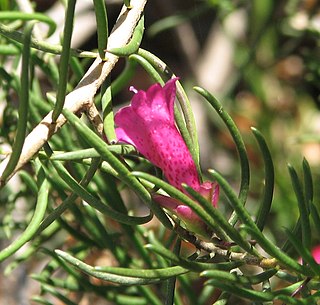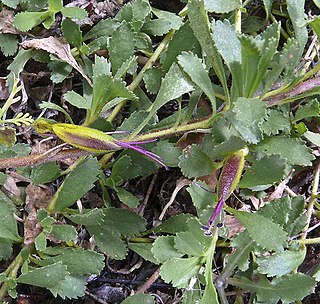
Eremophila alternifolia, commonly known as narrow-leaved poverty bush, is a plant in the figwort family, Scrophulariaceae, and is endemic to areas between the far west of New South Wales, the far south of the Northern Territory and the southern half of Western Australia. It is a variable shrub, with respect to its growth form, leaf shape and flower colour. Aboriginal Australians used the leaves to treat ailments such as colds and skin infections and pharmacological testing has shown that the leaves contain compounds that affect cardiac activity.

Eremophila maculata, also known as spotted emu bush, or spotted fuchsia-bush is a plant in the figwort family, Scrophulariaceae and is endemic to Australia. It is the most widespread of its genus in nature and probably the most frequently cultivated Eremophila. It is a spreading, often densely branched shrub with variable leaf shape and flower colour, but the other features of the flowers such as the size and shape of the parts are consistent. The inside of the flower is often, but not always spotted.

Eremophila clarkei, commonly known as turpentine bush, is a flowering plant in the figwort family, Scrophulariaceae and is endemic to Western Australia, South Australia and the Northern Territory. It is a shrub which is variable in form, but usually with narrow leaves and white or pale pink flowers. It is similar to Eremophila georgei and Eremophila granitica.
Eremophila barbata is a flowering plant in the figwort family, Scrophulariaceae and is endemic to a small area in the Eyre Peninsula of South Australia. It is a very rare, small, spreading shrub distinguished by a prominent "beard" on the lower lobe of its lilac-coloured flowers.

Eremophila biserrata, also known as prostrate eremophila, is a flowering plant in the figwort family, Scrophulariaceae and is endemic to a small area in the south of Western Australia. It is a prostrate shrub covering an area of up to about 2 m2 (20 sq ft) and which has serrated leaves and flowers that are green and yellow.

Eremophila linearis, commonly known as harlequin fuchsia bush, is a flowering plant in the figwort family, Scrophulariaceae and is endemic to Western Australia. It is a shrub with long leaves, sticky, shiny leaves and branches and bright red flowers

Eremophila sargentii is a flowering plant in the figwort family, Scrophulariaceae and is endemic to Western Australia. It is a shrub with sticky, shiny foliage, small leaves and mauve or blue flowers.
Eremophila verrucosa is a flowering plant in the figwort family, Scrophulariaceae and is endemic to South Australia. It is an erect, broom-shaped shrub with its leaves and branches covered with yellow-grey scales and lilac to purple flowers.

Gunniopsis is a genus of flowering plants in the iceplant family, Aizoaceae. These plants are found in areas of inland Australia.
Gunniopsis quadrifida, the Sturts pigface, is a plant endemic to Australia that that is within the family Aizoaceae. This family consists of a diverse array of species that inhabit arid and/or saline coastal and inland areas, with the plants displaying leaf morphology that is conducive to such harsh environments. Typical features of members of this genus that lie within this family of succulents includes the presence of fleshy-leaves that acts as a water reservoir for the plant with the habit of a smalls shrub.
Gunniopsis calcarea, commonly known as the Nullarbor Gunniopsis or the yellow flowered pigface, is a succulent plant in the iceplant family, Aizoaceae. It is endemic to Australia.
Gunniopsis zygophylloides, commonly known as the twin-leaf pigface, is a succulent plant in the iceplant family, Aizoaceae. It is endemic to Australia.
Gunniopsis divisa is a succulent plant in the iceplant family, Aizoaceae. It is endemic to Western Australia.
Gunniopsis calva, commonly known as the smooth pigface, is a succulent plant in the iceplant family, Aizoaceae. It is endemic to Australia.
Gunniopsis propinqua is a succulent plant in the iceplant family, Aizoaceae. It is endemic to Western Australia.
Gunniopsis rubra is a succulent plant in the iceplant family, Aizoaceae. It is endemic to Western Australia.
Gunniopsis septifraga, commonly known as green pigface, is a succulent plant in the iceplant family, Aizoaceae. It is endemic to Australia.
Gunniopsis papillata, commonly known as the twin-leaf pigface, is a succulent plant in the iceplant family, Aizoaceae. It is endemic to Australia.
Gunniopsis kochii, commonly known as the Koch's pigface, is a succulent plant in the iceplant family, Aizoaceae. It is endemic to Australia.

Carpobrotus modestus, commonly known as inland pigface, is a succulent perennial of the family Aizoaceae, native to the coasts of Australia. It produces purple flowers which mature into fruits and is mainly used as a groundcover succulent or as a drought tolerant plant.







